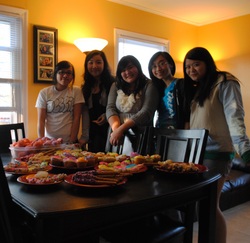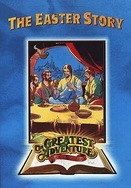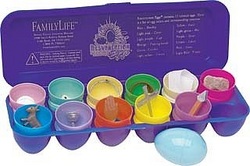This spring as Easter approached Christian began asking me questions about the Easter Bunny at the mall, and I was faced again with the hard question of how to explain a cultural icon to my children. This situation was much more difficult than explaining Santa Claus because there is not a generous, Christian man represented by the Easter Bunny. However, I still felt compelled to neither reject nor receive Easter traditions but to redeem them!
Greg and I have chosen not to reject Easter traditions (i.e. refusing to participate in egg hunts or even call Resurrection Sunday "Easter") but we have also decided not to completely receive Easter traditions (i.e. getting so caught up in the hype of egg hunts and the Easter Bunny that we forget to celebrate Jesus' resurrection). Greg and I have six Easter traditions we plan on doing with our children each year, and I feel that each one honors Jesus Christ.

Our family goes to church together on Good Friday evening to remember Jesus' death and we also go to church together on Sunday morning to celebrate Jesus' resurrection. We go to church every Friday evening and Sunday morning, so this is definitely more than an annual tradition for our family but it is vital to our understanding of the true meaning of Easter.

On Good Friday each year I make hot cross buns. Hot Cross Buns are a little time-consuming (roughly 3 1/2 hours preparation time), so I only make them on Good Friday making the tradition all the more special to our family. On Good Friday we talk a lot about the cross and why today is a very important day to us, so beginning our morning with icing crosses on sticky buns is a wonderful way to start these conversations.
Ingredients:
3/4 cup warm water
3 Tbs. butter
1 Tbs. instant powdered milk
1/4 cup white sugar
3/4 tsp. salt
1 egg
1 egg white
3 cups all-purpose flour
1 Tbs. active dry yeast
1 tsp. ground cinnamon
1 egg yolk
2 Tbs. water
1/2 cup powdered sugar
1/4 tsp. vanilla extract
2 tsp. milk
Directions:
1. Put warm water, butter, skim milk powder, 1/4 cup sugar, salt, egg, egg white, flour, and yeast in bread maker and start on dough program. (Takes approximately 1 ½ hours.)
2. Punch down on floured surface, cover, and let rest 10 minutes.
3. Shape into 12 balls and place in a greased 9 x 12 inch pan.
4. Cover and let rise in a warm place till double, about 35-40 minutes. -OR- For overnight: Cover tightly with plastic wrap and store in the refrigerator overnight or up to 16 hours. Remove the rolls from the refrigerator and place in an oven that is turned off. Fill a shallow pan 2/3-full of boiling water and set on the rack below the rolls. Close the oven door and let the rolls rise until they look slightly puffy; approximately 30 minutes. Remove the rolls and the shallow pan of water from the oven. Preheat the oven to 375 degrees F.
4. Mix egg yolk and 2 tablespoons water. Brush on balls.
5. Bake at 375 degrees for 20 minutes. Remove from pan immediately and cool on wire rack.
6. Mix together powdered sugar, vanilla, and milk. Drizzle a cross with the icing.

On Easter morning we make resurrection rolls together. Each part of the preparation process is symbolic. The marshmallow being dipped in butter and cinnamon represents Jesus' body being prepared for burial, the marshmallow being placed in the crescent roll represents Jesus' burial, and after the baking process is complete the marshmallow has dissolved leaving an empty tomb (very exciting for toddlers)! These tasty treats are perfect for Resurrection Sunday morning because they take less than 1/2 an hour to prepare (important for a family getting ready for church) and remind us of the joy of Jesus' resurrection that we are about to celebrate.
Ingredients:
2 (10 ounce) cans refrigerated crescent dinner rolls
16 large marshmallows
1/2 cup melted butter
4 Tbs. ground cinnamon
4 Tbs. white sugar
Directions:
1. Preheat oven to 400 degrees F (200 degrees C). Lightly grease a baking sheet.
2. Separate crescent rolls into individual triangles.
3. Read John 19:38-42. Explain that we are going to pretend to be Joseph and Nicodemus preparing aloe and myrrh. Melt the butter in a shallow pan. In a small bowl, mix together cinnamon and sugar.
4. Explain that we are going to pretend to be Joseph and Nicodemus placing the aloe and myrrh on Jesus body to prepare it for burial. Dip a marshmallow into melted butter, then roll in sugar mixture.
5. Explain that we are going to pretend to be Joseph and Nicodemus placing Jesus body in the tomb. Place marshmallow into the center of a dough triangle. Carefully wrap the dough around the marshmallow. Pinch the seams together tightly to seal in marshmallow as it melts. Place on a baking sheet. Repeat.
5. Bake in a preheated oven until golden brown, about 15 minutes. Explain that we are pretending to be Jesus followers waiting three long days while Jesus remained dead in the tomb.
6. Read Matthew 28:5-8. Explain that we are going to pretend to be the women followers of Jesus who went to the tomb and discovered it was empty! Have the children open their tombs and joyfully discover that they are empty! Enjoy eating the delicious resurrection rolls!

We always make lots of Easter treats to give to our friends and neighbors! This year we had five fabulous youth group girls over and help us make pink and purple rise krispie treat eggs, bunny, chick, and egg cookies and cupcakes, and flower chocolates on pretzel sticks! These treats were delicious, and hopefully we showed the love of Jesus first to our youth group girls while they were with us and second to our neighbors who received the yummy treats.

The Greatest Adventure: Easter Story movie is a wonderful, short movie that begins with Palm Sunday and ends with Jesus' ascension. We have watched this movie together almost every day this past week. This movie is wonderful because it allows children to catch a glimpse of Jesus' suffering without being too intense for them to handle. We also watch Veggie Tales: Twas the Night Before Easter and Veggie Tales: An Easter Carol (almost all the Veggie Tale movies are on Netflix - super blessing)!
In addition to Easter movies we also read the Biblical story of Easter in the God's Story for Me children's Bible we read each night for family devotions.

Every year we have several of Christian and Abbie's little friends over to our home to dye Easter eggs together. They always have a fabulous time dying, painting, glittering, and decorating their eggs. I embrace every opportunity to create memories with my children and reach out to their friends.

This is a new tradition to our family that we will be starting next Easter. We have ordered our set and are excited to use them next year! This set is typically $16 but is on sale for only $13 at Shop Family Life. You can also easily make your own set with a regular egg carton, 12 plastic eggs, and a little creativity!
The children open up each of the twelve eggs which contains little symbols that represent part of the Easter story. As the children systematically open the twelve eggs and each tiny object is discussed the story of Easter is told. We feel this will be a wonderful way to kick-off our annual, Easter afternoon, family Easter egg hunt.
On Easter afternoon our kids love collecting their brightly colored eggs filled with jellybeans that we have hidden around the house. Easter morning they also receive Easter baskets filled with goodies. We are honest with our kids and tell them Daddy & Mommy hid the Easter eggs and gave them the baskets of goodies. We explain to them that some people like to pretend that the Easter Bunny delivered the treats, but they are in on the "secret." We have told our kids that even though they know the Easter Bunny isn't real, they shouldn't ruin the fun for some of their friends who believe in the Easter Bunny by telling them he's a fake.
Eggs symbolize new life about to emerge, and have been used as traditional symbols of springtime and rebirth by various cultures throughout history.
Bunnies likely originated because the British pagans used to celebrate a spring feast in honor of the goddess Eostre, who was represented by the hare. Rabbits are conspicuous in the spring because they breed... like rabbits, and have also been used as traditional symbols of springtime and rebirth by various cultures throughout history.
The first known mention of the actual Easter Bunny comes from Germany in the 1600s, where the bunny was known as the Osterhase (pronounced “Oschter Haws”). German immigrants came to America with a tradition in which the kids would build nests around the house out of hats and bonnets, and if they had been good children, Osterhase would leave brightly-colored eggs in the nests. The tradition grew and spread over time, and eventually Osterhase turned into the Easter Bunny and began giving out chocolate and candy as well as eggs.
The celebration of the Day of Resurrection fell on the month of Eastre (West Saxon) or Eostre (Northumbrian), so the celebration was associated with the name of a month. The month's name was probably derived from a goddess of spring named Eostre, in whose honor feasts were celebrated in that month. The celebration of the Day of Resurrection replaced the old spring feast of Eostre, therefore the Christian holiday came to be called Easter.
Is it wrong to use the name “Easter” if it came from the name of a month that was named after a pagan goddess?
No – what is most important is what the word means today. If you use the word "Easter" in normal speech today, people make no association with an ancient pagan religion. Hundreds of millions of Christians use "Easter," and have done so for centuries, with the meaning of "the celebration of the resurrection of Jesus."
Additionally, there are many words we use that have long-passed connections in pagan culture or religion, but their meaning has been changed. When we talk about going to church on "Sunday" we don’t worry about the fact that this day in the Roman calendar was for the worship of the sun. And when we pass into January we mark a new beginning with little concern that the word "January" comes from the Roman god Janus, the god of doorways. Many of the words we use have some peculiar etymology. What matters is what the words mean to us today in normal spoken language.
No - in Scripture God reveals himself to humanity by reaching people through their culture.
Jesus took on flesh and intervened in a point of time in history to bring eternal life through faith in Him. He did not disassociate from relics of the culture but used them to display His glory through His miracles.
Jesus spoke to the Samaritan woman in John 4:1-26 using water analogies she could understand when revealing Himself to her as Messiah. He used parable to help people understand spiritual truths in their own context.
Paul does this on Mars Hill in Acts 17:16-32. Paul did not approach the Athenian court, slashing and burning their idols for Jesus. No, he used the pagan thought and symbolism to point to Christ, even citing their own poetry to identify who this God is that they consider 'unknown'.
Christians should engage in contextualization - expressing the message of the gospel and worship in the language or forms of the local people - that in no way implies doctrinal compromise. Christians around the world have sought to redeem the local culture for Christ, and we should do the same.
Instead of rejecting eggs and bunnies, why not use them to highlight the resurrection? By giving Easter treats and dying eggs with friends, we will open doors for spiritual discussions. I personally think we can do more harm by chastising the use of these objects/ideas than by using them to point to Christ. It is not like the ones who incorporate bunnies and eggs into the holiday are worshiping a pagan deity, but it is a meaningless symbol that produces a lot of fun. Why not turn it into something meaningful for the cause of Christ?

